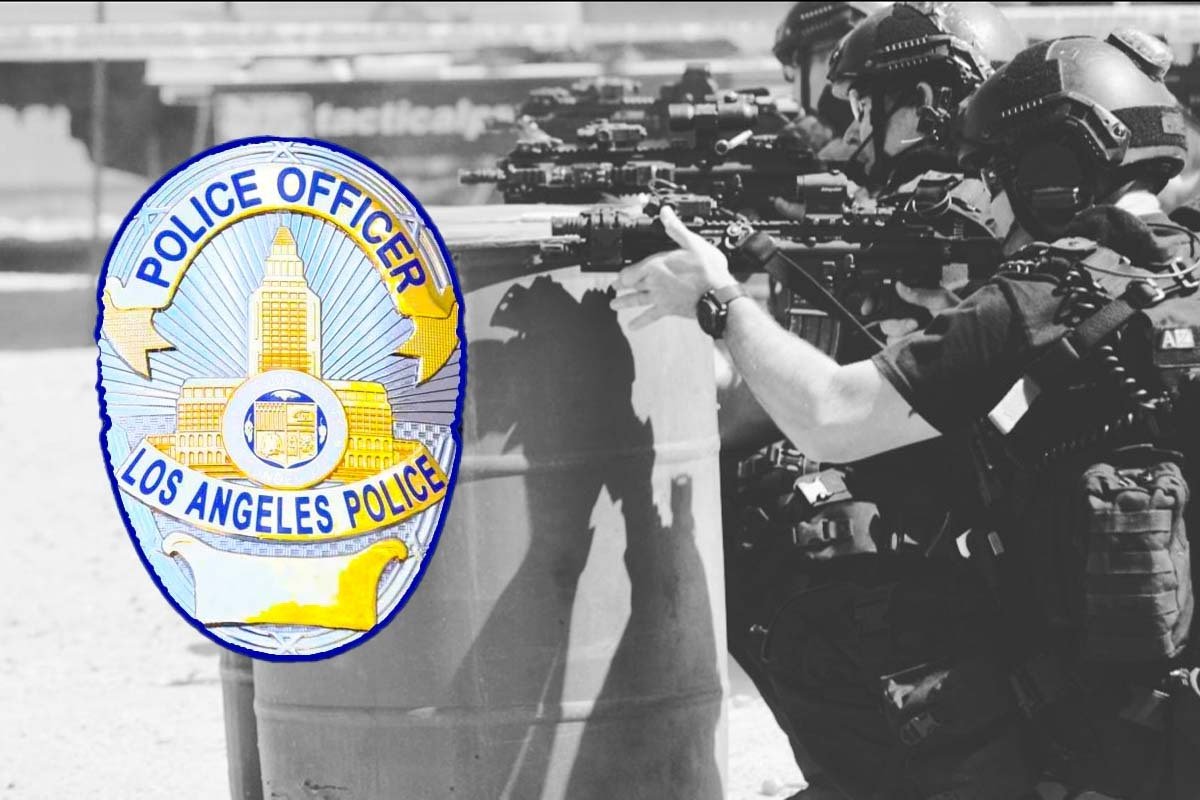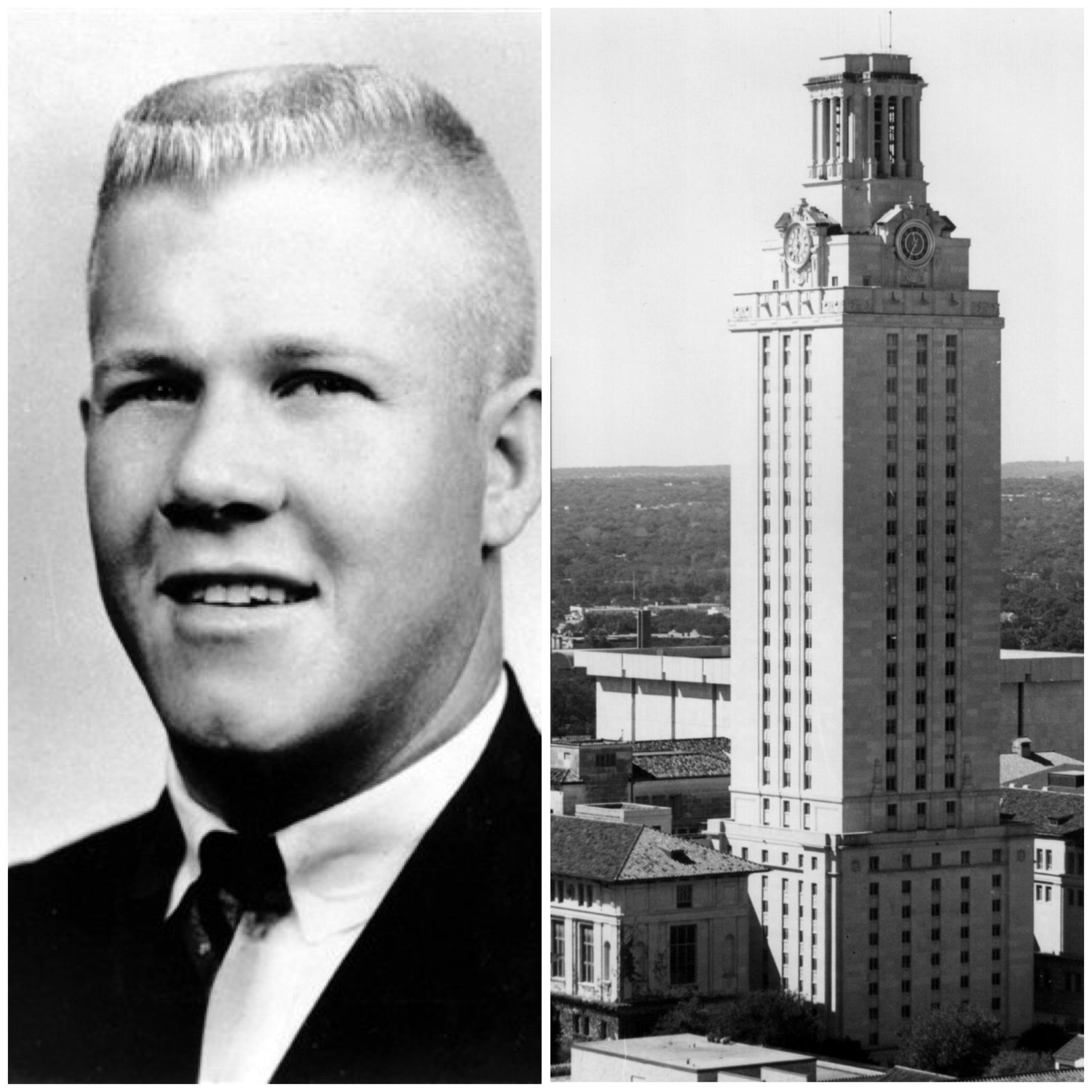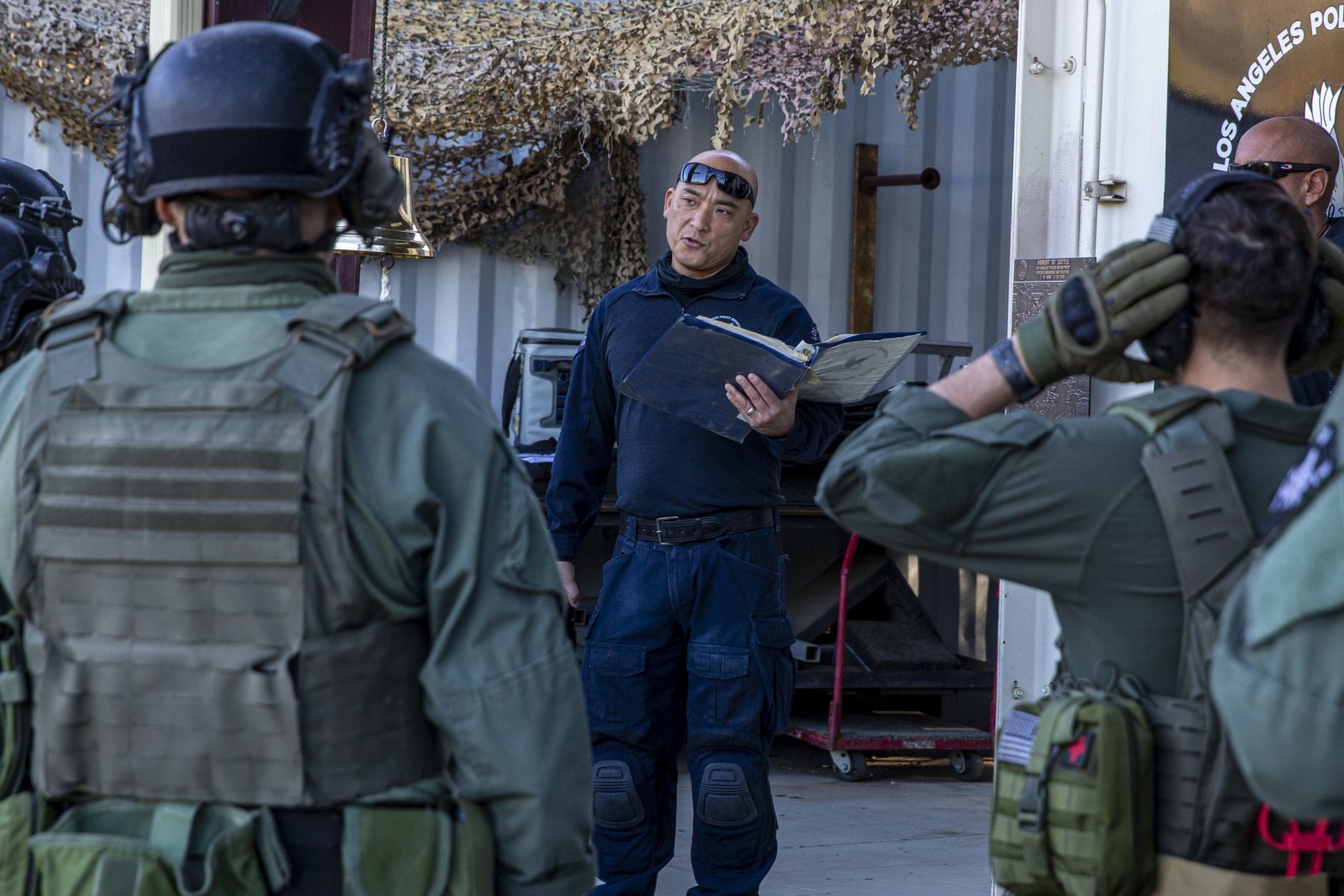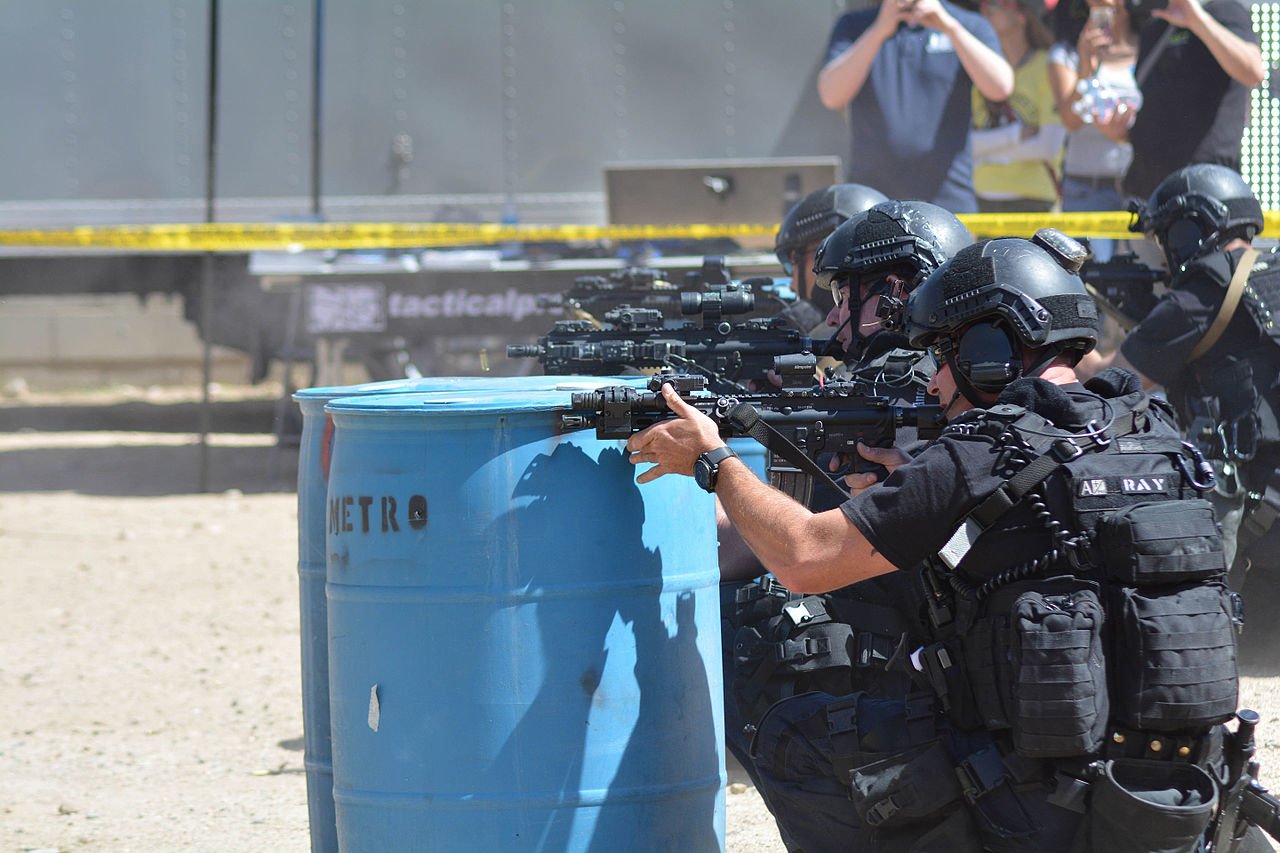
The Los Angeles Police Department was the first major police force to stand up a SWAT team. The team has responded to thousands of calls in the decades since. Composite by Coffee or Die Magazine.
In the 1960s, law enforcement around the country saw a shift in criminal behavior. Local police departments struggled to deal with a rise in high-profile crimes committed against civilians and police officers. These crimes often occurred in public areas, with criminals armed with high-powered rifles. One of the most notable incidents occurred on Aug. 1, 1966.
Charles Whitman, a former Marine and honor student at the University of Texas, climbed to the top of the University of Texas clock tower building with three rifles, two pistols, and a shotgun. In the next 96 minutes, he murdered more than a dozen people and wounded 30 more, targeting people at random as they strolled the college campus and nearby sidewalks. Responding officers couldn’t effectively stop Whitman with their service weapons and soon became targets themselves. A group of police officers formulated a plan to use an underground tunnel on campus to infiltrate the clock tower and reach Whitman, who was on the 27th floor. A gunfight ensued, and two officers, armed with a pistol and a shotgun, killed Whitman.

Shortly after the “Texas tower sniper” incident reached national news, police chiefs around the country began contemplating a change in policing to respond to future mass murder events effectively. Many consider this incident the spark that began a nationwide move toward the SWAT concept in US policing.
In Los Angeles, with growing interest in setting up tactical response teams to counter an increase of violent crimes during and immediately after the 1965 Watts riots, the Los Angeles Police Department created the city’s first SWAT team.
Police Sgt. John Nelson first presented the idea to future-Chief Daryl Gates, then a commander. When Gates brought the idea to his superiors, he proposed to call the unit a “Special Weapons Attack Team.” His superiors turned him down. Gates later reflected that the proposal had met with more resistance to the name than to the idea itself. He changed the name to “Special Weapons and Tactics” and purposed the concept once more.
The first LAPD SWAT team consisted of four 15-man elements, including a special weapons marksman, an observer, and two shotgun officers.

“These units, known as ‘station defense teams,’ provided security for police facilities during civil unrest, like the mini riots of 1968,” a 2017 Los Angeles Police Museum article by Robert Taylor reads. “During some training sessions, John Nelson would have units map the city sewer system as possible entry and escape routes.”
The LAPD SWAT team’s first real test came in December 1969. The targets of its search warrants for illegal weapons were members of the Black Panther Party, a Black liberation organization that had traded gunshots with police earlier in the year during several arrests. The LAPD SWAT team served no-knock warrants at three locations simultaneously. At the Black Panther headquarters at 41st and Central streets, a four-hour siege ensued, and thousands of rounds of ammunition were fired. The confrontation resulted in three Panthers and three police officers being wounded.
“The Panthers finally surrendered to SWAT officers, after department approval had been granted to deploy a Light Antitank Weapon on the headquarters,” Taylor writes. “Panthers members who were monitoring the police frequency decided to display a white pillow slip from a window near the entrance and give up.”
The operation proved SWAT to be effective. However, it also served as an early controversial instance in which a SWAT team seemed to blur the line between military combat and law enforcement.

In 1973 and 1974, the Symbionese Liberation Army, an anti-government domestic terrorist organization, committed a spree of high-profile crimes that included kidnapping 19-year-old heiress Patricia Hearst and the murder of Oakland superintendent of schools Marcus Foster. In May 1974, the LAPD investigators managed to track down an SLA safe house in South Central Los Angeles after finding a parking ticket in an abandoned SLA getaway vehicle. The LAPD SWAT team established a perimeter around the neighborhood and evacuated citizens living in the community.
The SLA members barricaded themselves in the building. SWAT rescued the non-SLA members who ran outside. A gun battle ensued. After the terrorists didn’t respond to verbal commands to surrender, SWAT employed tear gas. The SLA reportedly shot an estimated 3,700 rounds, but a fire erupted in the barricaded home, killing the SLA members inside.
Still, in the decades of SWAT enforcement, the LAPD says that the decisive, well-trained actions of SWAT teams remain a safe option for both police officers and the public. The deaths of suspects are rare in SWAT actions, according to the department.
“From 1972 to 2005, the period for which statistics are available, there were 3,371 SWAT missions,” according to the LAPD. “Of those, only 31 resulted in the death of a suspect.”
As the 1984 Olympics in Los Angeles approached, international attention swung toward the city. Local politicians and national security administrators entrusted Gates, now the LAPD chief, with leading the effort to keep crime out of the areas that would host the Games. Just 12 years before, terrorists had raided the Games in Munich, killing 11 Israeli athletes and coaches and one police officer. Investigations found that German authorities had not been prepared for terrorist violence, nor had they had well-trained response teams.

In 1983, Gates sent three SWAT supervisors to Europe to develop tactics in hostage rescue; they trained with Germany’s GSG 9, France’s GIGN, and the British Special Air Service.
But Gates’ SWAT and paramilitary approach to the Games led to complaints of harassment and police violence in the mostly Black and Latino neighborhoods in South Central LA, particularly around the Los Angeles Coliseum, just south of downtown.
“As a result, for many poor African American or Latino youths living in the South Central neighborhoods surrounding the Coliseum — the venue which hosted opening and closing ceremonies as well as track and field events — the Olympic Games did not lead to prosperity,” a Washington Post article reads. “But they did lead to the greater possibility of police harassment, arrest and incarceration that came to be associated with the War on Drugs.”
The Olympics went off without a security hitch, but the era that followed under Gates is remembered for tough policing principles that many say led to an erosion of trust between residents and the police. Under the banner of fighting gang violence, Gates enacted massive neighborhood sweeps through Black and Latino communities.
The tensions exploded in 1992 with days of rioting after the on-video police beating of Rodney King. When the LAPD officers involved were acquitted of charges, the city erupted in four days of riots, killing 45, injuring thousands, and costing more than $1 billion in property damages. Gates, the man considered the “father of SWAT” for his pioneering expertise, resigned.
Read Next: LAPD Veteran: Defunding, Disbanding Police Departments Is Not the Answer

Matt Fratus is a history staff writer for Coffee or Die. He prides himself on uncovering the most fascinating tales of history by sharing them through any means of engaging storytelling. He writes for his micro-blog @LateNightHistory on Instagram, where he shares the story behind the image. He is also the host of the Late Night History podcast. When not writing about history, Matt enjoys volunteering for One More Wave and rooting for Boston sports teams.
BRCC and Bad Moon Print Press team up for an exclusive, limited-edition T-shirt design!
BRCC partners with Team Room Design for an exclusive T-shirt release!
Thirty Seconds Out has partnered with BRCC for an exclusive shirt design invoking the God of Winter.
Lucas O'Hara of Grizzly Forge has teamed up with BRCC for a badass, exclusive Shirt Club T-shirt design featuring his most popular knife and tiomahawk.
Coffee or Die sits down with one of the graphic designers behind Black Rifle Coffee's signature look and vibe.
Biden will award the Medal of Honor to a Vietnam War Army helicopter pilot who risked his life to save a reconnaissance team from almost certain death.
Ever wonder how much Jack Mandaville would f*ck sh*t up if he went back in time? The American Revolution didn't even see him coming.
A nearly 200-year-old West Point time capsule that at first appeared to yield little more than dust contains hidden treasure, the US Military Academy said.












